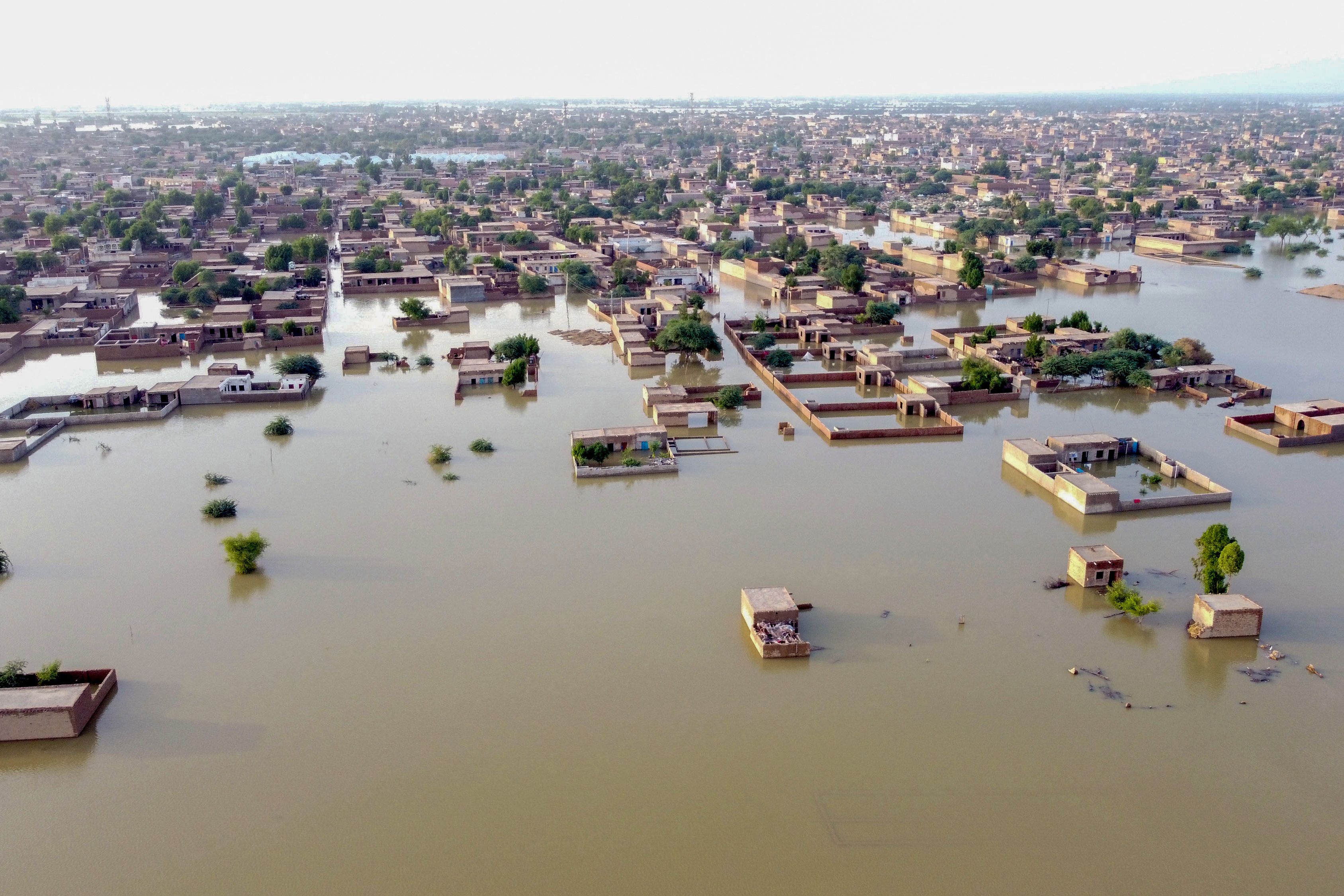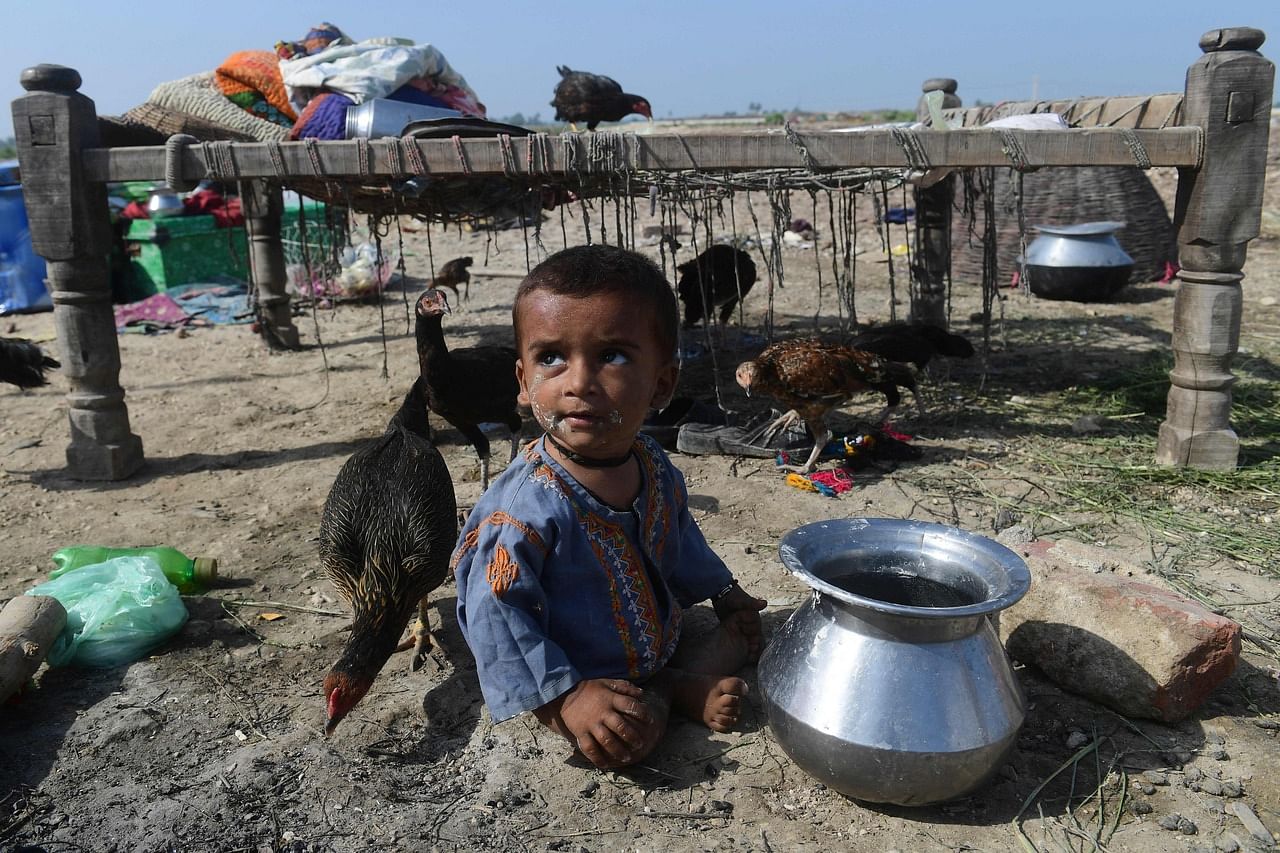Pakistan floods leave a third of country under water, cause surging food inflation
Sign up now: Get insights on Asia's fast-moving developments

The rains that began in June have unleashed the worst flooding in more than a decade.
PHOTO: AFP
Follow topic:
SUKKUR, PAKISTAN (AFP) - Aid efforts ramped up across flooded Pakistan on Tuesday (Aug 30) to help tens of millions of people affected by relentless monsoon rains that have submerged a third of the country and claimed more than 1,100 lives.
The rains that began in June have unleashed the worst flooding in more than a decade, washing away swathes of vital crops and damaging or destroying more than a million homes.
Authorities and charities are struggling to accelerate aid delivery to more than 33 million people affected, a challenging task in areas cut off because roads and bridges have been washed away.
In the south and west, dry land is limited, with displaced people crammed on to elevated highways and railroad tracks to escape the flooded plains.
"We don't even have space to cook food. We need help," Rimsha Bibi, a schoolgirl in Dera Ghazi Khan in central Pakistan, told AFP.
Pakistan receives heavy - often destructive - rains during its annual monsoon season, which are crucial for agriculture and water supplies.
But such intense downpours have not been seen for three decades.
Pakistani officials have blamed climate change, which is increasing the frequency and intensity of extreme weather around the world.
"To see the devastation on the ground is really mind-boggling," Pakistan's climate change minister Sherry Rehman told AFP.
"When we send in water pumps, they say 'Where do we pump the water?' It's all one big ocean, there's no dry land to pump the water out."
She said "literally a third" of the country was under water, comparing scenes from the disaster to a dystopian movie.
Planning Minister Ahsan Iqbal said Pakistan needed more than US$10 billion (S$14 billion) to repair and rebuild damaged infrastructure.
“Massive damage has been caused... especially in the areas of telecommunications, roads, agriculture and livelihoods,” he told AFP Tuesday.
The Indus River, which runs along the length of the South Asian nation, is threatening to burst its banks as torrents of water rush downstream from its tributaries in the north.


The meteorological office says the country as a whole had been deluged with twice the usual monsoon rainfall, but Balochistan and Sindh provinces had seen more than four times the average of the last three decades.
'Pakistan is drowning'
The disaster could not have come at a worse time for Pakistan, where the economy is in free fall.
The government has declared an emergency and appealed for international help.
Aid flights have arrived in recent days from Turkey and the UAE, while other nations including Canada, Australia and Japan have also pledged assistance.
The United Nations has announced it will launch a formal US$160 million appeal on Tuesday to fund emergency aid.
Pakistan was already desperate for international support and the floods have compounded the challenge.


Finance Minister Miftah Ismail has told local media that the disaster could cost upwards of US$10 billion, and on Monday said "Pakistan is drowning".
There was some relief on Monday when the International Monetary Fund approved the revival of a loan programme for Pakistan, releasing an initial US$1.1 billion.
Makeshift relief camps have sprung up all over Pakistan - in schools, on motorways and in military bases.
In the northwestern town of Nowshera, a technical college was turned into a shelter for up to 2,500 flood victims.
They sweltered in the summer heat with sporadic food aid and little access to water.
"I never thought that one day we will have to live like this," said 60-year-old Malang Jan. "We have lost our heaven and are now forced to live a miserable life."


Displaced people receive food packets at a makeshift camp in Nowshera, Pakistan, on Aug 29, 2022.
PHOTO: AFP
'Back-breaking' food inflation
The floods are fuelling food inflation.
Prices of basic goods - particularly onions, tomatoes and chickpeas - are soaring as vendors bemoan a lack of supplies from the flooded breadbasket provinces of Sindh and Punjab.
“Things are so expensive because of this flood that we can’t buy anything,” said Zahida Bibi, who had come to a market in the central city of Lahore to get vegetables for dinner.
She told AFP she had to forego some items on her shopping list because inflation had put them out of reach.
“What can we do? We don’t make enough money to buy things at such high prices.” Onions and tomatoes – common ingredients in most Pakistani meals – have been affected the most.


Finance Minister Miftah Ismail said the price of onions had shot up by more than five times, and that the government was trying to quickly implement policies to stabilise food prices – including importing from arch-rival India.
“We need to consider getting some vegetables over the land border,” he told broadcaster Geo News on Monday.
“We have to do it because of the kind of prices and shortages we are experiencing... Inflation has broken people’s backs.”
Out of reach
With millions of acres of farmland still under water and certain roads inaccessible, prices are expected to climb further.
“About 80 per cent of the tomato crop in Pakistan has been damaged in the floods, and onion supply has been badly hit as well,” Shahzad Cheema, secretary of the Lahore Market Committee, told AFP.
“These are basic items, and ultimately it is the average buyer who will be most affected.”
Vegetable seller Muhammad Owais at a market in Lahore was struggling to find buyers at the current high prices.
“Prices have increased so much because of (the flood) that many customers leave without buying anything,” he told AFP.
Pakistan was struggling with record high inflation even before the floods, because of rising global oil prices and a balance of payments crisis.
Red Cross has launched a public fund-raising appeal from Aug 29 to Nov 30 to support the relief and recovery operations.


